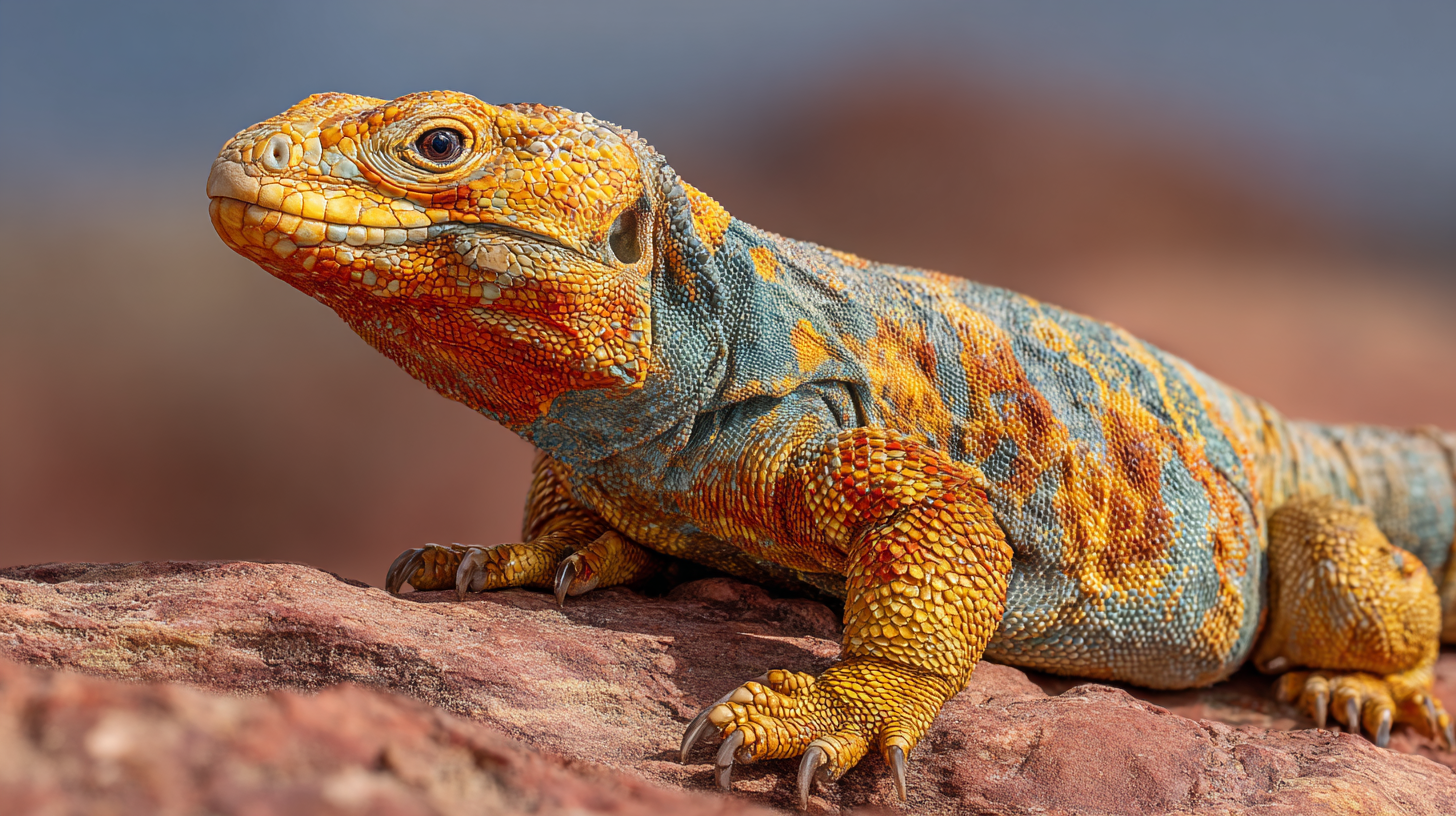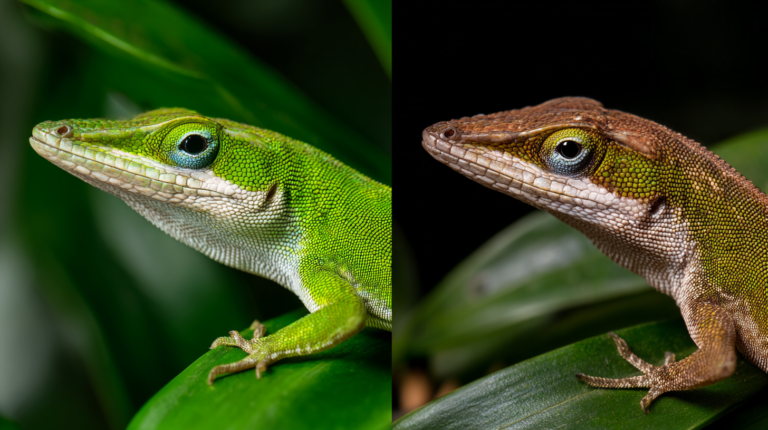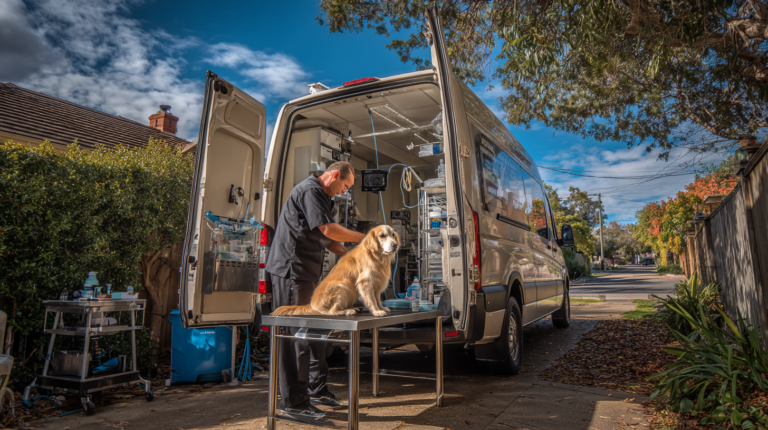Find trusted Uromastyx for sale from top breeders. Complete 2025 guide covering costs, care requirements, and expert tips for these amazing desert lizards. 30+ year commitment made simple.
Table of Contents
Did you know that Uromastyx lizards can live up to 30 years in captivity when properly cared for? These magnificent desert dwellers, often called “spiny-tailed lizards,” have become increasingly popular among reptile enthusiasts across the United States and Europe. If you’re searching for Uromastyx for sale, finding a reputable breeder is crucial for ensuring you bring home a healthy, well-socialized lizard that will thrive in your care.
The exotic pet market has grown exponentially, with reptile ownership increasing by 44% over the past decade according to the American Pet Products Association. However, this surge has also led to an influx of unscrupulous sellers offering poorly bred or unhealthy animals. When it comes to Uromastyx for sale, the difference between a reputable breeder and a backyard dealer can mean the difference between a thriving pet and years of veterinary bills.
Living in Arizona for over a decade, I’ve witnessed firsthand how the desert climate mirrors the natural habitat these incredible lizards come from. My journey with Uromastyx began when I rescued a neglected Egyptian Uromastyx from an inexperienced owner who had purchased from an unreliable source. That experience taught me the critical importance of choosing the right breeder from the start.
This comprehensive guide will walk you through the top 5 trusted breeders offering Uromastyx for sale, essential care requirements, and everything you need to know before welcoming one of these spectacular lizards into your home.
Understanding Uromastyx: The Perfect Reptilian Companion
Uromastyx lizards, belonging to the family Agamidae, are native to the arid regions of Africa, the Middle East, and parts of Asia. These herbivorous reptiles have adapted to some of the harshest desert environments on Earth, making them surprisingly hardy pets when their specific needs are met.
There are over 18 recognized species of Uromastyx, with some of the most popular for captivity including:
- Egyptian Uromastyx (Uromastyx aegyptia): Known for their vibrant colors and docile temperament
- Mali Uromastyx (Uromastyx maliensis): Smaller species perfect for beginners
- Ornate Uromastyx (Uromastyx ornata): Stunning patterns and colors
- Moroccan Uromastyx (Uromastyx acanthinura): Hardy and adaptable to various setups
- Rainbow Uromastyx (Uromastyx benti): Rare and highly sought after for their spectacular coloration
Why Choose a Uromastyx as Your Next Pet?
Unlike many reptiles, Uromastyx are primarily herbivorous, making their dietary requirements more manageable than carnivorous species. They’re also known for their intelligence and can recognize their owners, often becoming quite personable with proper socialization.
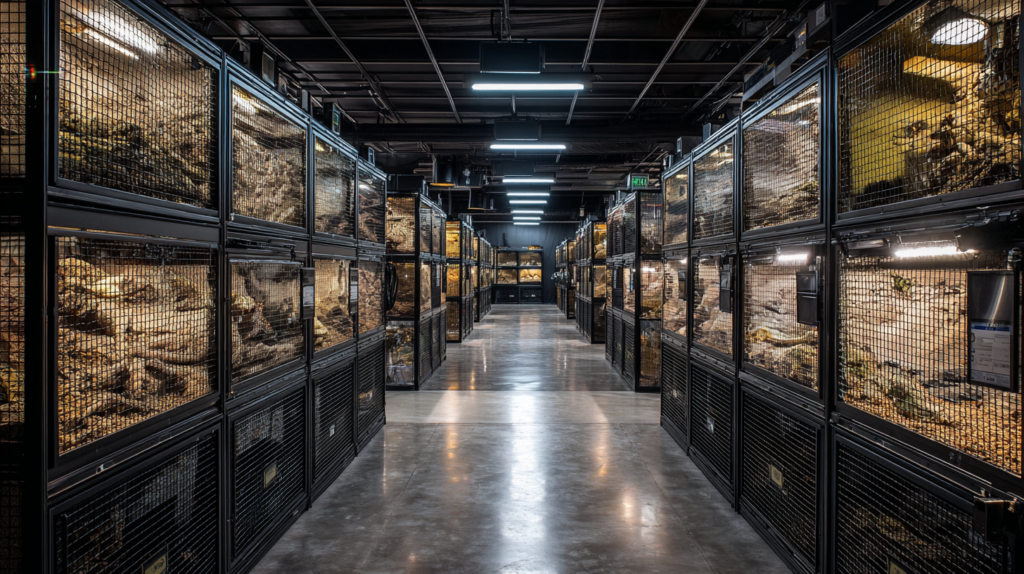
For more expert pet care tips and product recommendations, visit BlithePet your trusted source for pet wellness.
Table 1: Uromastyx Species Comparison for Beginners
| Species | Adult Size | Beginner Friendly | Average Lifespan | Temperature Requirements | Price Range |
|---|---|---|---|---|---|
| Mali Uromastyx | 10-14 inches | Excellent | 15-20 years | Basking: 120-130°F | $150-$300 |
| Egyptian Uromastyx | 24-30 inches | Good | 20-30 years | Basking: 130-140°F | $300-$800 |
| Ornate Uromastyx | 12-16 inches | Good | 15-25 years | Basking: 125-135°F | $200-$500 |
| Moroccan Uromastyx | 16-20 inches | Very Good | 20-25 years | Basking: 125-135°F | $250-$600 |
| Rainbow Uromastyx | 14-18 inches | Moderate | 20-30 years | Basking: 130-140°F | $800-$2000 |
Top 5 Trusted Breeders for Uromastyx for Sale
Finding reputable breeders when searching for Uromastyx for sale requires careful research and verification. Here are five trusted sources that have consistently provided healthy, well-cared-for Uromastyx to reptile enthusiasts across the United States and Europe.
1. Underground Reptiles
Location: Deerfield Beach, Florida, USA
Years in Business: 25+ years
Specialties: Wide variety of Uromastyx species, captive-bred animals
Underground Reptiles has established itself as one of the most reliable sources for Uromastyx for sale in North America. They maintain detailed health records for all their animals and provide comprehensive care sheets with every purchase. Their facility undergoes regular veterinary inspections, and they offer a live arrival guarantee on all shipments.
What sets them apart:
- Detailed genetic lineage tracking for breeding animals
- 72-hour health guarantee on all Uromastyx
- Comprehensive setup guidance for new owners
- Regular veterinary health checks
Customer testimonial: “I purchased my Egyptian Uromastyx from Underground Reptiles three years ago, and he’s been nothing but healthy and vibrant. Their customer service team answered all my questions before and after the purchase.” – Sarah M., Texas
2. Backwater Reptiles
Location: Rocklin, California, USA
Years in Business: 20+ years
Specialties: Rare color morphs, captive-bred Uromastyx
Backwater Reptiles focuses on producing high-quality, captive-bred Uromastyx with exceptional coloration and temperament. They’re particularly known for their work with rare morphs and have contributed significantly to the captive breeding programs for several Uromastyx species.
What sets them apart:
- Specialization in rare color morphs
- Detailed photographic documentation of each animal
- Lifetime breeder support
- Educational workshops for new Uromastyx owners
3. LLLReptile
Location: Multiple locations across the USA
Years in Business: 30+ years
Specialties: Complete Uromastyx setups, educational resources
LLLReptile offers not just Uromastyx for sale, but complete habitat setups and ongoing support. They’re known for their educational approach, ensuring customers understand the commitment involved in Uromastyx ownership before making a purchase.
What sets them apart:
- Complete habitat packages available
- Extensive educational resources
- Multiple physical locations for in-person consultations
- Strong focus on proper husbandry education
4. Reptile Specialty (Europe)
Location: Multiple European locations
Years in Business: 15+ years
Specialties: European captive-bred Uromastyx, CITES compliance
For European customers seeking Uromastyx for sale, Reptile Specialty offers locally bred animals that comply with all CITES regulations. They work closely with European zoos and conservation programs to maintain genetic diversity in captive populations.
What sets them apart:
- Full CITES compliance and documentation
- Collaboration with European conservation programs
- Local breeding reduces shipping stress
- Multilingual customer support
5. The Bio Dude
Location: Baton Rouge, Louisiana, USA
Years in Business: 10+ years
Specialties: Bioactive setups, naturalistic approaches
The Bio Dude has revolutionized reptile keeping with their bioactive approach. When searching for Uromastyx for sale, they provide animals that are already accustomed to naturalistic setups, making the transition to your home smoother.
What sets them apart:
- Bioactive habitat specialization
- Animals pre-conditioned to naturalistic environments
- Complete ecosystem setup services
- Focus on natural behaviors and enrichment
Essential Requirements Before Purchasing Uromastyx for Sale
Before you start looking for Uromastyx for sale, it’s crucial to understand the significant commitment involved in proper Uromastyx care. These aren’t impulse pets – they require specialized equipment, specific environmental conditions, and a long-term commitment that can span decades.
Habitat Requirements
Enclosure Size: Adult Uromastyx need substantial space. A 75-gallon tank is the absolute minimum for smaller species, while larger species like Egyptian Uromastyx require 120+ gallon enclosures or custom-built habitats.
Lighting Requirements: Uromastyx need both UVB lighting (12-14% UVB) and intense basking heat. A quality UVB bulb costs $40-60 and needs replacement every 6-12 months.
Temperature Gradients: These desert dwellers require extreme temperature gradients:
- Basking spot: 120-140°F (species dependent)
- Warm side: 95-105°F
- Cool side: 80-85°F
- Nighttime drop: 70-75°F
Dietary Considerations
Unlike many reptiles, Uromastyx are primarily herbivorous. Their diet should consist of:
- 95% vegetables and greens (collard greens, mustard greens, turnip greens)
- 5% seeds and grains (bird seed mixes, lentils)
- Occasional flowers (hibiscus, dandelions)
- NO fruits (too high in sugar)
- NO animal protein (can cause kidney damage)
Table 2: Uromastyx Setup Costs and Requirements
| Setup Component | Initial Cost | Annual Replacement | Importance Level | Notes |
|---|---|---|---|---|
| 120-gallon Tank | $200-$400 | N/A | Critical | Minimum for adult Uromastyx |
| UVB Lighting (T5 HO) | $80-$120 | $60-$80 | Critical | 12-14% UVB required |
| Basking Light | $25-$50 | $15-$30 | Critical | 150W+ ceramic heat emitter |
| Digital Thermometer | $20-$40 | $10-$20 | Critical | Accuracy is vital |
| Substrate | $30-$60 | $50-$100 | Important | Sand/soil mix, 6+ inches deep |
| Hide Boxes | $40-$80 | N/A | Important | Multiple sizes needed |
| Food Dish | $15-$30 | N/A | Moderate | Ceramic or stone preferred |
| Timer Systems | $40-$80 | N/A | Important | For lighting schedules |
Red Flags to Avoid When Looking for Uromastyx for Sale
Not all sources offering Uromastyx for sale are created equal. Here are critical warning signs that should make you look elsewhere:
Pricing Red Flags
Prices that seem too good to be true: A healthy, captive-bred Uromastyx typically costs $150-$800+ depending on species and age. Prices significantly below market value often indicate:
- Wild-caught animals (higher stress, parasites, shorter lifespan)
- Sick or injured animals
- Animals with genetic defects
- Scam operations
Breeder Behavior Warning Signs
Unwillingness to provide health records: Reputable breeders maintain detailed health and feeding records. If a seller can’t or won’t provide this information, walk away.
Pressure tactics: Quality breeders want their animals to go to prepared homes. Be wary of sellers who pressure you to buy immediately or seem uninterested in your experience level.
No questions about your setup: A good breeder will ask detailed questions about your prepared habitat, experience level, and long-term commitment.
Multiple species from questionable sources: Be cautious of sellers offering dozens of different reptile species – they may be dealers rather than breeders.
Health Red Flags in Animals
When viewing Uromastyx for sale, watch for these health warning signs:
Physical appearance issues:
- Visible ribs or hip bones (underweight)
- Swollen or cloudy eyes
- Mouth breathing or wheezing
- Tail or toe loss beyond normal shedding
- Lethargy or unresponsiveness
- Runny or discolored feces
Behavioral red flags:
- Aggression or extreme fear responses
- Inability to thermoregulate properly
- Refusing food for extended periods
- Excessive hiding or stress behaviors
8 Expert Tips for First-Time Uromastyx Owners
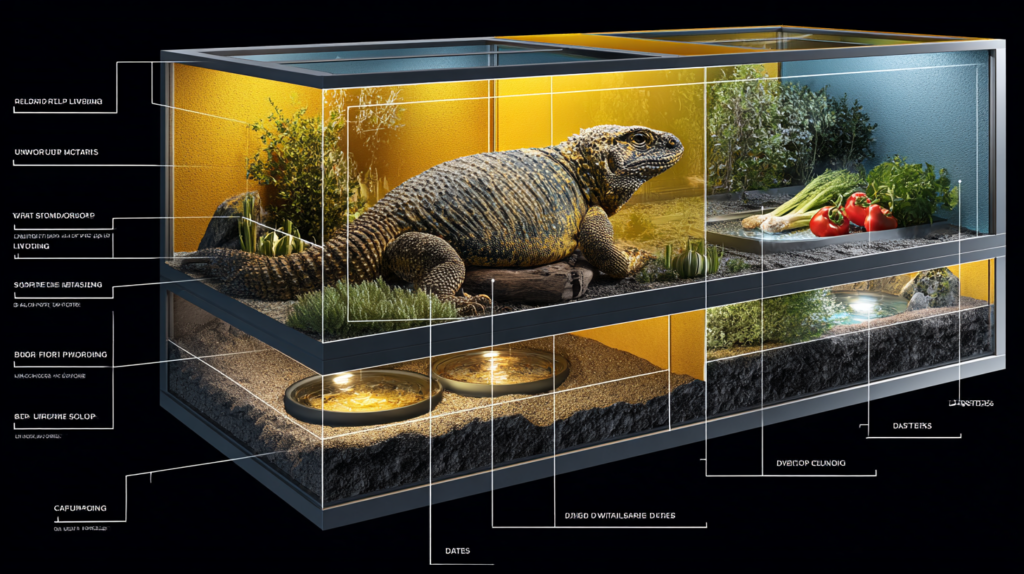
1. Start with Beginner-Friendly Species
If you’re new to Uromastyx ownership, consider starting with Mali or Moroccan Uromastyx. These species are more forgiving of minor husbandry mistakes and generally have better temperaments for handling.
2. Invest in Quality Equipment from Day One
Cheap equipment will cost you more in the long run. Invest in high-quality UVB lights, reliable thermostats, and accurate thermometers. Your Uromastyx’s health depends on precise environmental control.
3. Establish Veterinary Care Before You Need It
Find an exotic veterinarian familiar with Uromastyx before bringing your new pet home. Many standard veterinarians lack experience with these specialized reptiles.
4. Understand the Brumation Cycle
Uromastyx undergo brumation (similar to hibernation) during cooler months. This is normal behavior, but first-time owners often panic when their active lizard suddenly becomes lethargic and stops eating for weeks or months.
5. Provide Adequate Substrate Depth
Uromastyx are natural burrowers and need at least 6-8 inches of appropriate substrate to dig and thermoregulate naturally. This behavior is essential for their psychological well-being.
6. Monitor Humidity Carefully
These desert dwellers require low humidity (20-30%). High humidity can lead to respiratory infections and other health problems. Invest in a quality hygrometer and monitor levels daily.
7. Establish Consistent Daily Routines
Uromastyx thrive on routine. Maintain consistent lighting schedules (12-14 hours of light), feeding times, and handling sessions to reduce stress.
8. Plan for Growth and Longevity
Baby Uromastyx may seem fine in smaller enclosures, but they grow quickly. Plan your setup for adult size from the beginning, and remember you’re committing to potentially 30 years of care.
Common Mistakes That Lead to Health Problems
Inadequate Temperature Gradients
The most common mistake new Uromastyx owners make is insufficient basking temperatures. These lizards require basking spots of 120-140°F to properly digest food and maintain immune function. Surface temperatures should be measured with an infrared thermometer, not ambient air temperatures.
Improper Diet Composition
Many new owners treat Uromastyx like other reptiles, offering insects or fruits. This is harmful – Uromastyx are strict herbivores, and animal protein can cause kidney damage over time. Fruits are too high in sugar and can disrupt their gut flora.
Overcrowding and Inadequate Space
A cramped Uromastyx is a stressed Uromastyx. These active lizards need room to establish territories, bask properly, and exhibit natural behaviors. Don’t try to house multiple males together – they’re territorial and will fight.
When to Consult a Veterinarian
While Uromastyx are generally hardy reptiles, certain situations require immediate veterinary attention:
Emergency situations:
- Refusal to eat for more than 2 weeks outside of brumation season
- Visible injuries or wounds
- Difficulty breathing or mouth breathing
- Swollen or infected-looking eyes
- Unusual lethargy combined with other symptoms
- Any bleeding or discharge
Regular veterinary care should include:
- Annual wellness exams with fecal parasite checks
- Weight monitoring and body condition assessments
- UVB level testing in your habitat setup
- Nutritional counseling as needed
Remember, exotic veterinary care can be expensive – budget $200-500 annually for routine care, with emergency visits potentially costing much more.
Debunking Common Uromastyx Myths
Myth 1: “Uromastyx Don’t Need Water Dishes”
Reality: While Uromastyx get most of their hydration from food, they do occasionally drink water, especially during hot weather or illness. Provide a shallow water dish, but ensure it doesn’t raise humidity levels significantly.
Myth 2: “All Substrate Is the Same”
Reality: Substrate choice is critical for Uromastyx health. Avoid cedar or pine shavings (toxic), loose substrates that cause impaction (pure sand), or substrates that retain moisture (moss or bark chips). A mixture of play sand and organic topsoil works best.
Myth 3: “Uromastyx Can Live in Small Tanks”
Reality: Adult Uromastyx need significant space – 120 gallons is the absolute minimum, with larger being better. Small enclosures lead to stress, territorial behavior, and health problems.
Table 3: Annual Care Costs for Uromastyx Ownership
| Expense Category | Low Estimate | High Estimate | Frequency | Notes |
|---|---|---|---|---|
| Food (vegetables/seeds) | $200 | $400 | Weekly | Organic produces higher costs |
| UVB Bulb Replacement | $60 | $100 | 2x yearly | Quality bulbs last 6-12 months |
| Substrate Replacement | $50 | $120 | 2-3x yearly | Depends on enclosure size |
| Veterinary Care | $200 | $500 | Annual | Emergency care costs extra |
| Electricity (heating/lighting) | $180 | $350 | Monthly | Varies by local rates |
| Supplements | $30 | $60 | As needed | Calcium and multivitamins |
| Equipment Maintenance | $50 | $150 | As needed | Thermostats, timers, repairs |
| Total Annual Cost | $770 | $1,680 | Excluding initial setup |
Step-by-Step Guide: Preparing for Your New Uromastyx
Step 1: Research and Choose Your Species (2-4 weeks before purchase)
Spend time researching different Uromastyx species to determine which best fits your experience level and space constraints. Mali Uromastyx are excellent for beginners, while Egyptian Uromastyx require more advanced care.
Step 2: Set Up the Habitat (2-3 weeks before purchase)
Purchase and install all equipment, allowing time to establish proper temperature gradients and test all systems. Run the habitat for at least one week to ensure temperatures remain stable.
Step 3: Find an Exotic Veterinarian (1-2 weeks before purchase)
Research and contact exotic veterinarians in your area. Schedule a “new pet consultation” appointment for shortly after you bring your Uromastyx home.
Step 4: Source Quality Food Suppliers (1 week before purchase)
Identify reliable sources for fresh vegetables, organic greens, and appropriate seed mixes. Stock up on essentials so you’re ready when your new pet arrives.
Step 5: Contact Reputable Breeders (Ongoing)
Reach out to multiple breeders, ask questions about their breeding practices, health guarantees, and available animals. Don’t rush this process.
Step 6: Quarantine Preparation (If you have other reptiles)
Set up a separate quarantine area if you keep other reptiles. New animals should be quarantined for 60-90 days to prevent disease transmission.
Step 7: Final Equipment Check (Day before pickup/delivery)
Double-check all temperatures, lighting schedules, and equipment function. Ensure everything is running perfectly before your new Uromastyx arrives.
Step 8: Bringing Your Uromastyx Home
Transport your new pet in a secure, ventilated container with appropriate temperatures. Minimize stress by keeping handling to a minimum for the first week.
Regional Considerations for Uromastyx Ownership
United States Regulations
Most Uromastyx species are legal to own in the United States, but some states have specific regulations:
- California: Requires permits for some species
- Hawaii: Prohibits most reptile imports
- New York: City-specific restrictions may apply
- Florida: Enhanced regulations due to invasive species concerns
Always check local and state regulations before purchasing Uromastyx for sale in your area. Some municipalities have additional restrictions beyond state laws.
European Union Considerations
European customers looking for Uromastyx for sale must navigate CITES regulations and EU-specific import/export requirements:
- CITES Documentation: Required for most Uromastyx species
- Health Certificates: Veterinary health certificates needed for cross-border transport
- Quarantine Requirements: Some countries require quarantine periods
- Species-Specific Restrictions: Certain rare species may have additional protections
The European Union has strict regulations regarding the trade of exotic animals, making it essential to work with CITES-compliant breeders who understand the legal requirements.
Seasonal Care Considerations
Understanding Brumation
One of the most challenging aspects of Uromastyx ownership is understanding and managing their natural brumation cycle. During cooler months (typically October through March), healthy Uromastyx may enter a state similar to hibernation.
Normal brumation behaviors include:
- Decreased appetite or complete food refusal
- Increased sleeping and reduced activity
- Seeking cooler areas of the enclosure
- Minimal interest in basking
- Weight loss (up to 10-15% is normal)
When to be concerned during brumation:
- Rapid weight loss exceeding 20%
- Signs of illness before brumation begins
- Unusual lethargy combined with high temperatures
- Refusal to drink water when offered
Many first-time owners panic during their Uromastyx’s first brumation, but this is completely natural behavior. Continue offering food occasionally, but don’t be alarmed if it’s refused for weeks or even months.
Summer Care Adjustments
During hot summer months, even indoor Uromastyx may show behavioral changes:
- Increased basking time and heat-seeking behavior
- Higher appetite and more active feeding
- Increased territorial behaviors
- Greater interest in burrowing and substrate manipulation
Ensure your cooling systems can handle increased ambient temperatures, and consider backup power options for critical heating and lighting equipment.
Building a Relationship with Your Uromastyx
Socialization and Handling
Unlike many reptiles, well-socialized Uromastyx can become quite personable and may even seek interaction with their owners. However, this requires patience and proper technique:
Initial acclimation period (2-4 weeks):
- Minimal handling to reduce stress
- Allow the animal to observe you during feeding and maintenance
- Speak softly when working around the enclosure
- Move slowly and deliberately to avoid startling
Beginning handling (after 4+ weeks):
- Start with brief 5-10 minute sessions
- Support the body fully, never grab just the tail
- Allow the Uromastyx to walk from hand to hand
- Watch for stress signs (rapid breathing, color changes, aggressive posturing)
Advanced interaction (3+ months):
- Some individuals enjoy gentle scratching behind the head
- Supervised exploration outside the enclosure
- Recognition of feeding schedules and daily routines
- Possible toilet training (some Uromastyx learn to defecate in specific areas)
Recognizing Individual Personality
Each Uromastyx develops its own personality traits. Some become bold and curious, while others remain more reserved. Respect your individual animal’s temperament rather than forcing interactions.
Advanced Husbandry: Bioactive Setups
For experienced keepers, bioactive setups can provide enrichment and more naturalistic living conditions for Uromastyx for sale. These systems use live plants and beneficial microorganisms to create self-sustaining ecosystems.
Benefits of Bioactive Systems
- Natural waste processing: Beneficial bacteria break down waste products
- Humidity regulation: Live plants help maintain appropriate moisture levels
- Behavioral enrichment: More natural environment encourages natural behaviors
- Reduced maintenance: Less frequent substrate changes required
- Aesthetic appeal: More attractive and naturalistic appearance
Challenges of Bioactive Setups
- Higher initial cost: Quality bioactive substrates and plants are expensive
- Learning curve: Requires understanding of plant care and ecosystem balance
- Potential complications: Plant diseases or pest issues can affect the entire system
- Species compatibility: Not all plants are safe for Uromastyx consumption
Recommended Plants for Uromastyx Bioactive Setups
Safe, edible plants that thrive in arid conditions:
- Prickly pear cactus (Opuntia species): Provides food and shelter
- Aloe vera: Edible and medicinal properties
- Hibiscus: Colorful flowers provide occasional treats
- Desert willow: Attractive flowering tree for larger enclosures
- Various grasses: Provide natural foraging opportunities
Always research plant safety thoroughly, as some common houseplants are toxic to Uromastyx.
Breeding Considerations for Advanced Keepers
While most people seeking Uromastyx for sale are looking for pets rather than breeding stock, understanding breeding basics can help you appreciate quality animals and support conservation efforts.
Breeding Requirements
Successful Uromastyx breeding requires:
- Mature animals: Most species reach sexual maturity at 3-5 years
- Proper conditioning: Pre-breeding weight gain and optimal health
- Environmental cycling: Temperature and lighting changes to trigger breeding
- Adequate space: Large enclosures for territorial establishment
- Genetic diversity: Avoiding inbreeding through careful lineage tracking
Conservation Impact
Responsible captive breeding reduces pressure on wild populations and helps maintain genetic diversity in captivity. When purchasing Uromastyx for sale, always choose captive-bred animals over wild-caught specimens.
Health Monitoring and Record Keeping
Essential Health Monitoring
Successful Uromastyx ownership requires consistent health monitoring and record keeping:
Weekly monitoring:
- Weight checks (digital scale accurate to 1 gram)
- Visual health assessments
- Feeding response and appetite changes
- Behavioral observations
- Waste production and quality
Monthly assessments:
- Detailed photographic documentation
- Measurements (length, body condition)
- Equipment maintenance and calibration
- Habitat condition evaluation
Annual requirements:
- Veterinary wellness examinations
- Fecal parasite testing
- UVB meter readings of lighting systems
- Complete equipment replacement as needed
Digital Health Records
Many successful Uromastyx keepers maintain digital health records using smartphone apps or computer spreadsheets. These records become invaluable for veterinary consultations and tracking long-term health trends.
Essential record components:
- Daily temperatures (basking spot, ambient, cool side)
- Weekly weights and measurements
- Feeding schedules and food acceptance
- Behavioral observations and changes
- Veterinary visits and treatments
- Equipment maintenance and replacements
Emergency Preparedness
Power Outage Preparedness
Since Uromastyx require precise environmental conditions, power outages can quickly become life-threatening emergencies. Prepare for outages with:
Short-term solutions (4-8 hours):
- Battery-powered heat packs designed for reptile transport
- Insulated containers to maintain temperature
- Battery backup systems for critical equipment
Extended outage solutions (8+ hours):
- Portable generators (properly ventilated)
- Car power inverters for emergency heating
- Temporary relocation to heated facilities
- Emergency boarding with exotic veterinarians
Natural Disaster Planning
Depending on your location, prepare for region-specific disasters:
- Evacuation carriers that meet airline transport requirements
- Emergency supplies including 72 hours of food and water
- Veterinary contacts in potential evacuation areas
- Documentation including health records and ownership proof
FAQ Section :
Conclusion:
Searching for Uromastyx for sale is just the beginning of an incredible journey with one of nature’s most remarkable desert reptiles. These magnificent lizards offer unique personalities, fascinating behaviors, and the potential for decades of companionship – but only when their complex needs are fully understood and met.
The five trusted breeders highlighted in this guide represent the gold standard in Uromastyx for sale, offering healthy, well-socialized animals backed by comprehensive support and health guarantees. Remember that the lowest price isn’t always the best value when it comes to a 20-30 year commitment.
Before making your final decision, honestly assess your readiness for the financial commitment (initial setup costs of $500-$1200 plus annual costs of $770-$1680), time investment (daily care requirements), and long-term dedication these remarkable animals deserve. A well-cared-for Uromastyx will reward you with years of fascinating behaviors, unique personality, and the satisfaction of successfully keeping one of the desert’s most specialized reptiles.
The reptile keeping community is built on shared knowledge and responsible ownership. When you find the right Uromastyx for sale and provide excellent care, you’re not just gaining a pet – you’re contributing to conservation efforts and helping ensure these amazing animals continue to thrive in captivity for future generations to appreciate.
Are you ready to take the next step in your Uromastyx journey? Have you prepared the proper habitat and found an exotic veterinarian in your area? These final preparations will set both you and your new companion up for decades of success together.
Have a similar experience with your pet? Share it in the comments below! Don’t forget to check out our other helpful guides at BlithePet.com.

